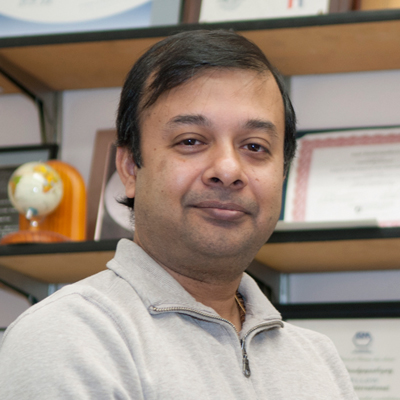Advanced technology in 3D printing to enable medical and aerospace applications
Almost eight years back, there was a neurosurgeon who was working with a patient suffering from a motorcycle injury. A big chunk of the patient’s skull had fallen out, and the neurosurgeon was desperately in search of an implant that could substitute the missing piece of the skull to help the patient gain back his life. Enter Dr. Amit Bandyopadhyay, a pioneer in 3D printing and additive manufacturing, who collaborated with the surgeon to measure the left side of the skull which remained intact, copy it, and design an implant that would be 3D printed to fit the rest of the skull. If only this concept could become commonplace reality, such product would be invaluable for patients. Dr. Amit Bandyopadhyay, Herman and Brita Lindholm Endowed Chair Professor of Mechanical and Materials Engineering at Washington State University, uses advanced manufacturing techniques for novel materials and coatings to solve emerging as well as long-standing challenges in healthcare, space and aerospace industries. The solutions that he derives will not only greatly benefit the medical and aerospace communities, but also further revolutionize the way products are made in the future.
A holder of 11 US issued patents and author of over 250 technical papers, Dr. Bandyopadhyay has been pioneering the field of 3D printing and additive manufacturing for the past two decades. He collaborates with physicians and industry partners from biomedical devices and space related projects to identify key challenges that can be addressed with 3D printing. To make one-of-a-kind elements catered to a specific need, Dr. Bandyopadhyay and his team join efforts to conduct practical, applied research whose concepts are proven to work, but which needs support for detailed animal studies that can further validate the product for human use. With increased experimental capacities, therefore, Dr. Bandyopadhyay hopes to bring his academic research out of the ivory towers and help produce unique devices that can truly perform in nearly any situation.
Current projects include:
- Patient-Matched Implants: Road traffic accidents alone bring an influx of patients into the emergency room, where there are no available implants for patients with fractures. Being able to design and manufacture implants according to the conditions of the patients’ fractures in a short period of time will greatly improve the lifestyle of the people who will have devices that match their own anatomy. By developing technology that allows for such solutions, Dr. Bandyopadhyay hopes to create a way for patients to heal faster and walk away with an improved quality of life.
- Infection-Resistant Devices: When asked what would be one dream that they’d like to see realized, physicians answered, “I’d like to control infection.” Most accidents happen outside, and by the time patients are brought to the emergency room, there is a substantial time delay and open wounds are exposed to a plethora of germs threatening to develop infections. In fact, 10~15% of patients will develop infections even after successful treatment and large amounts of antibiotics, which results in a traumatic process of waiting for the infection to heal before treating the wound again. Dr. Bandyopadhyay therefore works with advanced materials to print infection-resistant devices that guarantee infection-free zones wherever patients are treated with the device.
- 3D Printing for Space Research: Dr. Bandyopadhyay’s long-term goal is to print devices that are better than how they are performing today. Each pace shuttle and mission is different and require a specific part, and the cost of production is inevitably expensive to make one-of-a-kind materials for one-time purposes. Dr. Bandyopadhyay works with space researchers to help them minimize the cost and find the materials they are looking for with 3D printing and additive manufacturing; “if they can design it, they can print it.” However, only small parts can be made currently at Washington State University, with existing machine capabilities. With improved experimental capacities, Dr. Bandyopadhyay will be able to create larger materials that can truly facilitate space research.
Bio
Dr. Amit Bandyopadhyay is a Herman and Brita Lindholm Endowed Chair Professor in the School of Mechanical and Materials Engineering at Washington State University. His research expertise lies with additive manufacturing of metallic and ceramic materials and their composites towards structural, bio- and piezoelectric materials. He is a Fellow of the National Academy of Inventors (NAI), American Ceramic Society (ACerS), American Society for Materials (ASM International), American Institute for Medical and Biological Engineering (AIMBE) and American Association for the Advancement of Science (AAAS).
Dr. Amit Bandyopadhyay received his Ph.D. in Materials Science and Engineering from the University of Texas at Arlington in 1995. He joined the Center for Ceramics Research at Rutgers University for his postdoctoral training in 1995. In 1997, he joined the School of Mechanical and Materials Engineering (MME) at WSU as an Assistant Professor, was promoted to an Associate level in 2001, and to full professor level in 2006. Dr. Bandyopadhyay received the CAREER award from the NSF in 1999 and the Young Investigator Program (YIP) Award from the ONR in 1998. Dr. Bandyopadhyay also received the best research faculty awards in 2005 and 2008, and the best teaching faculty award in 2000 from the School of Mechanical and Materials Engineering at WSU.
He has published over 250 technical papers, and holds 11 US patents; six more patent applications are currently pending at the United States Patent and Trademark Office. He has also edited eight books. Dr. Bandyopadhyay has supervised and is supervising 14 Ph.D. and 22 M.S. graduate students for their degrees in mechanical engineering, physics and materials science and engineering. His students have moved to industry, academia and national labs within and outside the US. Dr. Bandyopadhyay has worked with over 35 undergraduate students from materials science, mechanical engineering, chemical engineering and bioengineering and published several journal papers and conference proceedings with them.
Outside of his research, Dr. Bandyopadhyay likes to garden and take summer trips. From fruits and flowers to vegetables, he plants and manages a sophisticated garden. Everyday, he is motivated to “do something that makes a difference in ordinary human life,” and continues to move forward into the future today.
For more information, visit http://labs.wsu.edu/bmrl/
In the News
Products Finishing
NSF Discoveries
The Wire
Publications
Awards
2015 Class of Fellows, National Academy of Inventors (NAI)
2012 Class of Fellows, American Association for the Advancement of Science (AAAS)
2012 Class of Fellows, American Society for Materials (ASM International)
2012 College of Fellows, American Institute for Medical and Biological Engineering (AIMBE)
2011 Class of Fellows, American Ceramic Society
Patents
U.S. Patent No. 8,545,559: “Modified metal materials, surface modifications to improve cell interactions and antimicrobial properties, and methods for modifying metal surface properties.”
Bandyopadhyay A., Bose S. Issued Patent by the US Patent and Trademark Office.
U.S. Patent No. 8,916,198: “Mesoporous calcium silicate compositions and methods for synthesis of mesoporous calcium silicate for controlled release of bioactive agents.”
Bandyopadhyay A., Bose S., Xue W. Issued Patent by the US Patent and Trademark Office.
U.S. Patent No. 9,028,871: “Resorbable ceramics with controlled strength loss rates.”
Bose S., Bandyopadhyay A. Issued Patent by the US Patent and Trademark Office.
U.S. Patent No. 6,571,008: “Reverse Engineering of Polymeric Solid Models by Refractive Index Matching.”
Bandyopadhyay A., Christensen J. C. Issued Patent by the US Patent and Trademark Office.
U.S. Patent No. 6,049,160: “Radial Ceramic Piezoelectric composites.”
Bandyopadhyay A., Danforth S. C., McNulty T., Panda R. K., Safari, A. Issued Patent by the US Patent and Trademark Office.


